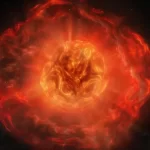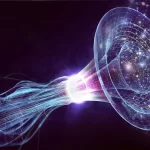Key Takeaways:
- Unexpected Brilliance: The James Webb Space Telescope (JWST) has unveiled galaxies from the universe’s infancy that are remarkably brighter than anticipated.
- Star Formation Frenzy: Computer simulations propose that this luminosity is a result of intense bursts of star formation in these early galaxies.
- Challenging the Standard Model: Initially, this discovery raised questions about the established model of cosmology, which predicted galaxies forming differently.
- Bursty Star Formation: This phenomenon, common in low-mass galaxies, involves rapid cycles of star birth, explosion, and subsequent rebirth.
- Validating Cosmological Model: Recent simulations support the hierarchical growth model of galaxies, reinforcing our understanding of cosmic evolution.

The early universe has long been shrouded in mystery, with questions about the formation and brilliance of galaxies lingering in the minds of astronomers. The advent of the James Webb Space Telescope (JWST) in 2022 marked a significant milestone in space exploration, enabling scientists to peer back in time to a period less than 400 million years after the Big Bang. What they discovered was nothing short of astonishing: galaxies that outshone even the boldest predictions of the standard model of cosmology.
Initially, this celestial revelation seemed to challenge the very foundations of our understanding. According to the established model, galaxies begin as modest entities, gradually growing through mergers driven by the gravitational interplay of dark matter filaments and cosmic halos. The brilliant galaxies uncovered by JWST, however, defied this narrative, appearing far more luminous than anticipated for their era.
A team led by Guochao Sun of Caltech set out to unravel this cosmic enigma. Through sophisticated computer simulations, they delved into the processes governing the formation of these early galaxies. What emerged from their virtual experiments was a revelation: it wasn’t size that conferred brilliance, but rather a frenzy of star formation occurring during this epoch.

In the tumultuous early universe, starbursts were not uncommon. Such events, akin to fireworks in the night sky, were witnessed even in contemporary galaxies, often triggered by galactic collisions. In this cosmic ballet, molecular gases, stirred by the forces of gravity, fragmented and collapsed, giving rise to a burst of stars. This pattern, it seems, was echoed in the first galaxies, where star-forming material accrued in fits and starts.
Claude-André Faucher-Giguère of Northwestern University explains, “Bursty star formation is especially common in low-mass galaxies. What we think happens is that a burst of stars form, then a few million years later those stars explode as supernovae. The gas gets kicked out [of the galaxy] and then falls back in to form new stars, driving the cycle of star formation.”
The early galaxies, far smaller than their contemporary counterparts, grew by accreting intergalactic clouds of gas and engaging in cosmic mergers. As they expanded, their gravitational pull augmented, allowing them to retain more of their star-forming material. This stabilized the pace of star production, in stark contrast to the frenetic early years.
Most notably, the outcomes of these simulations aligned seamlessly with the hierarchical growth model outlined in the standard cosmological paradigm. Faucher-Giguère emphasized, “Our simulations show that galaxies have no problem forming this brightness by cosmic dawn.”
This groundbreaking revelation, published in The Astrophysical Journal Letters on October 3, not only sheds light on the brilliance of early galaxies but also reinforces our understanding of cosmic evolution. The James Webb Space Telescope, with its unprecedented capabilities, continues to unravel the secrets of the universe, reaffirming that even the most established models of cosmology have much to learn from the cosmos itself.
Originally published on Space.com


